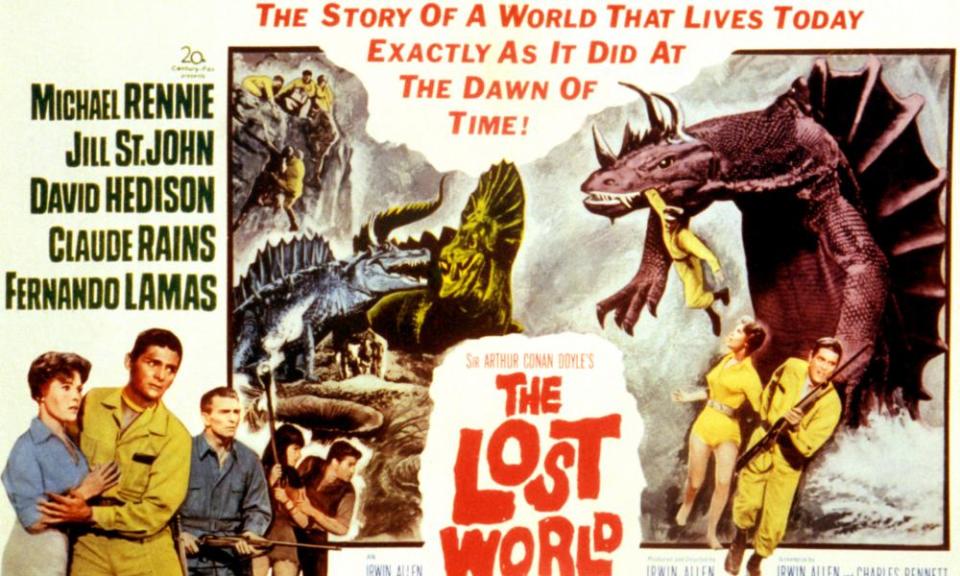The photo is the clue: Arthur Conan Doyle’s love for his Lost World hero
Sir Arthur Conan Doyle’s Professor Challenger, the fictional scientist and explorer who discovers a forgotten land of dinosaurs, went on to inspire a string of adventure films, including Jurassic Park. He was a headstrong and irascible antihero, but there is now proof he also served as his creator’s literary alter ego.
The evidence of handwritten notes and amendments, laid out this week with the first publication of the full manuscript of Conan Doyle’s original and most famous Challenger story, The Lost World, show the author not only posed for a photograph of himself dressed as the professor, but also initially gave the character his own age and address.
Conan Doyle spent much of his writing career distancing himself from his best-known creation, Sherlock Holmes, and his family later spoke of the great detective as “a curse”. Yet it seems Conan Doyle was happy to be confused with Challenger.

“The reason he is like Challenger, and why he felt so close, is that Conan Doyle never really grew out of the boyish side of himself. It was very important to him,” said the American Conan Doyle expert Jon Lellenberg, who advises on the author’s literary estate. “He wrote that Challenger ‘always amused me more than any other which I had invented’.”
Conan Doyle imagined Challenger as a kind of antidote to Sherlock’s analytical personality and was excited about his first appearance in The Lost World, serialised in the Strand Magazine from April 1912. “It promises to be a great success,” he wrote, “I should be surprised if it is not the bestseller of any book I have ever done.”
Conan Doyle even persuaded his friends to join him in posing for a mocked-up photograph of the story’s imaginary expedition team. They appear grouped around a table before they set off for a hidden mountain plateau above the Amazon river in search of creatures from the Jurassic age. Conan Doyle hoped the image of himself in a fake beard and bushy eyebrows would give his story an air of authenticity, but the editor refused to print it.
“Conan Doyle took some inspiration for Challenger from a physiology professor at Edinburgh who had made a great impression on his students by starting his lectures as he walked up the corridor, booming away before he actually came in,” said Lellenberg. “I don’t think adaptations of this particular story will ever stop. All the other Challenger tales have something to recommend them but the first one hit it right on the head. There is a new television version of The Lost World in development now in Hollywood.”
The original tale is narrated by Challenger’s future son-in-law, reporter Ned Malone, who serves as a kind of Dr Watson. On meeting the professor, he is amazed by his “enormous head”. “I am sure that his top hat, had I ventured to don it, would have slipped over me entirely and rested on my shoulders. He had the face and beard, which I associate with an Assyrian bull; the former florid, the latter so black as almost to have a suspicion of blue, spade-shaped and rippling down over his chest,” Malone records.
Handwritten edits to the text show the author decided against his initial instinct to give Challenger his own age and home address, scratching them out later. He also edited the character, making him less extreme in his views and behaviour.
Unlike Holmes, Challenger is quick to anger and in deep mourning for the loss of his wife, Jessie. But he does share the great detective’s large ego and is described in the novel as seeing “himself sometimes, gracing the vacant pedestal in Trafalgar Square”.
In a foreword to the manuscript, published by SP Books today, Lellenberg argues that Conan Doyle’s “busy” handwriting and the lack of edits towards the climax of the story show the author’s growing excitement. And although the editor at the Strand declined to use the photographs, which went on to appear in a later edition of the story in book form, he did at least predict the story’s great popularity, calling it “the very best serial [bar special S. Holmes values] that I have ever done, especially when it has the trimmings of faked photos, maps and plans.”

 Yahoo Finance
Yahoo Finance 